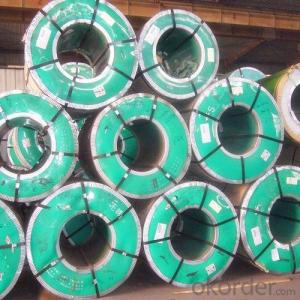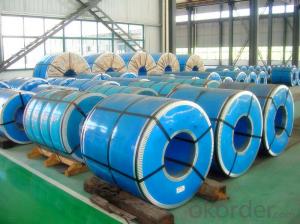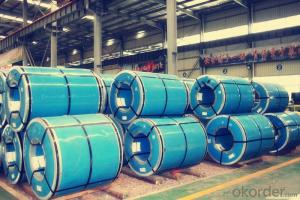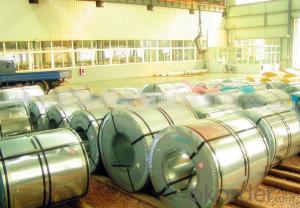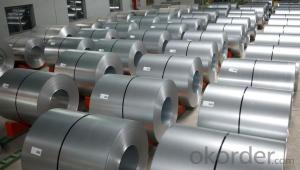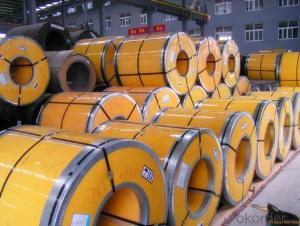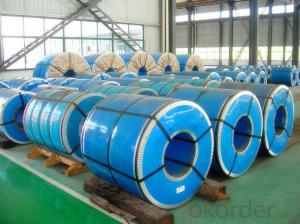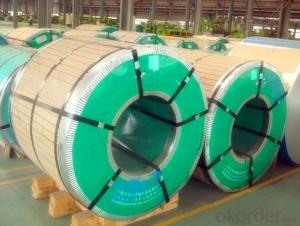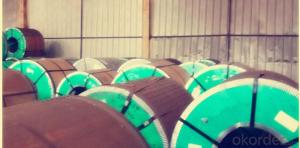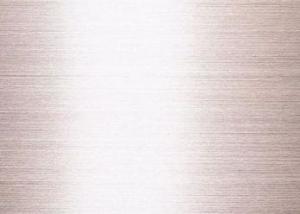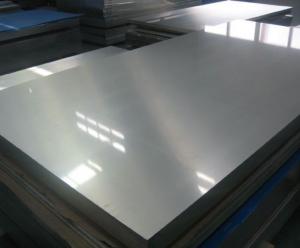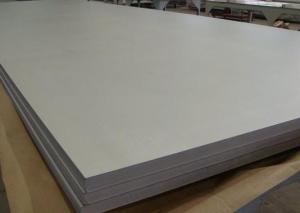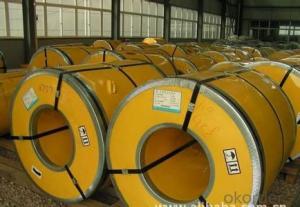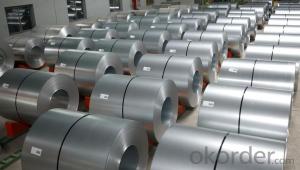Hot Rolled Stainless Steel Coil 304 No.1 Wide Strip
OKorder Service Pledge
OKorder Financial Service
You Might Also Like
Hot Rolled Stainless Steel Coil 304 (Annealing and Pickling) No.1 Finish Wide Strip
1.surface:NO.1
2.standard:JIS, AISI, GB
3.width: 1.0m, 1.22m, 1.5m, 2m or requirement
Hot Rolled Stainless Steel Coil 304 Chemical Composition:
(%):C=0.07, Mn=2.00, P=0.045, S=0.030, Si=0.075, Cr=17.5-19.5, Ni=8.0-10.5, N=0.10
Hot Rolled Stainless Steel Coil 304 Physical Properties
Tensile strength σb (MPa) ≥ 520
the conditions yield strength σ0.2 (MPa) ≥ 205,
elongation δ5 (%) ≥ 40
Reduction of ψ (%) ≥ 50,
hardness: ≤ 187
HB; ≤ 90
HRB; ≤ 200H
Type | Hot Rolled Stainless Steel Coil 304 |
Thickness | 3.0mm-4.0mm |
Width | 1000mm, 1219mm, 1240mm, 1500mm |
Length | according to weight |
Brand name | CNBM |
Standard | ASTM, AISI, DIN, GB, JIS etc |
Material | 304 |
Application | Foodstuff, Gas, metallurgy, biology, electron, chemical, petroleum, boiler, nuclear energy, Medical equipment, fertilizer etc |
Package | Standard export sea-worthy packing |
Delivery time | Within 15 days since getting the deposit or LC origin |
Surface | NO.1 |
Productivity | 20000 tons/month |
Grade: | 300 Series | Standard: | JIS,AISI,ASTM,GB,DIN,EN etc | Thickness: | 2.5mm, 3.0mm, 4.0mm |
Width: | 1000mm, 1219mm, 1240mm, 1500mm | Length: | according to weight | Place of Origin: | China (Mainland) |
Brand Name: | CNBM | Model Number: | 304 | Technique: | Hot Rolled |
Application: | industry, construction, furniture, repairing | Certification: | MTC | Finishing: | NO.1 |
Market: | globle area | Packaged: | wooden and bags in cases as standard | Payment: | TT & LC |
Delivery time: | 15 days | MOQ: | 100 tons | Advantage: | prime quality, competitive price |
Profession: | hot rolled | Charactor: | stainless steel coils | Material/Grade: | 304 |
- Q: How do stainless steel strips perform in high-humidity environments?
- Stainless steel strips are highly resistant to corrosion and are therefore suitable for use in high-humidity environments. The chromium content in stainless steel forms a protective layer on the surface, preventing the metal from interacting with moisture and humidity. This protective layer, known as the passive film, remains intact even in high-humidity conditions, ensuring that the stainless steel strip maintains its structural integrity. Additionally, stainless steel has a low thermal conductivity, which means it does not easily absorb or retain moisture from the surrounding environment. This property further enhances its performance in high-humidity environments by reducing the risk of moisture buildup and subsequent corrosion. In summary, stainless steel strips are an excellent choice for applications in high-humidity environments due to their corrosion-resistant properties and ability to withstand moisture without compromising their performance or structural integrity.
- Q: How do stainless steel strips perform in the presence of ammonia?
- Ammonia is generally well tolerated by stainless steel strips, which are widely recognized for their outstanding resistance to corrosion. This resistance is particularly evident when it comes to ammonia and its compounds, thanks to the high chromium content present in stainless steel. This chromium forms a protective layer on the surface, effectively shielding the metal from any reactions with ammonia. Moreover, stainless steel's non-porous nature further enhances its ability to repel ammonia and reduce the likelihood of corrosion. Nevertheless, it is worth noting that the performance of stainless steel strips in the presence of ammonia can be influenced by various factors, including the concentration and temperature of the ammonia solution, as well as the specific grade and surface finish of the stainless steel. Consequently, it is advisable to seek guidance from stainless steel manufacturers or corrosion experts when using stainless steel strips with ammonia. This way, the most suitable material selection and maintenance practices can be ensured for specific applications involving stainless steel strips and ammonia.
- Q: Can 111 stainless steel strips be passivated to enhance corrosion resistance?
- Certainly! Passivation can improve the corrosion resistance of 111 stainless steel strips. It involves removing iron from the surface and creating a protective oxide layer. This layer acts as a barrier, preventing further corrosion and increasing resistance to chemicals, moisture, and temperature. Industries such as automotive, aerospace, medical, and food processing commonly use passivation to enhance the longevity and performance of stainless steel components. Consequently, by passivating the 111 stainless steel strips, their corrosion resistance can be enhanced, resulting in improved durability and reliability for their intended applications.
- Q: How long do stainless steel strips last?
- Stainless steel strips have a remarkably long lifespan, often lasting for several decades or even longer. The durability and corrosion resistance of stainless steel make it highly resistant to rust, tarnish, and deterioration. The actual longevity of stainless steel strips depends on various factors such as the grade of stainless steel used, the environmental conditions in which they are used or stored, and the level of maintenance they receive. However, with proper care and maintenance, stainless steel strips can last for a lifetime, making them an excellent choice for various applications in industries like construction, automotive, and manufacturing.
- Q: How do stainless steel strips compare to aluminum strips in terms of strength?
- Stainless steel strips generally have higher strength compared to aluminum strips. Stainless steel is known for its excellent strength and durability, which makes it suitable for various applications that require resistance to corrosion, heat, and impact. On the other hand, aluminum strips are relatively less strong but are lightweight and have good corrosion resistance. While aluminum strips may not match the strength of stainless steel, they are often preferred in industries where weight is a critical factor, such as aerospace and automotive. Ultimately, the choice between stainless steel and aluminum strips depends on the specific requirements of the application, balancing strength, weight, and other properties.
- Q: Are stainless steel strips resistant to oxidation?
- Yes, stainless steel strips are resistant to oxidation. This is because stainless steel is an alloy that contains chromium, which reacts with oxygen in the air to form a protective layer on the surface called chromium oxide. This layer acts as a barrier, preventing further oxidation or corrosion of the metal. As a result, stainless steel strips are highly resistant to rust and corrosion, making them ideal for applications where exposure to moisture or harsh environments is a concern.
- Q: Can stainless steel strips be used in medical equipment?
- Yes, stainless steel strips can be used in medical equipment. Stainless steel is commonly used in the medical industry due to its excellent corrosion resistance, durability, and ease of sterilization. It is often utilized in medical instruments, surgical tools, implants, and medical device components.
- Q: How do stainless steel strips perform in high-temperature environments?
- Stainless steel strips generally perform well in high-temperature environments due to their excellent heat resistance properties. They can withstand elevated temperatures without significant structural changes or loss of strength. Additionally, stainless steel strips have a low thermal expansion coefficient, allowing them to maintain dimensional stability even when exposed to extreme heat.
- Q: Can stainless steel strips be used in architectural column systems?
- Yes, stainless steel strips can be used in architectural column systems. Stainless steel is a versatile material that offers several benefits for architectural applications. It is durable, corrosion-resistant, and has a sleek and modern appearance, making it an ideal choice for column systems in buildings. Stainless steel strips can be used to create decorative cladding or coverings for columns, providing an aesthetically pleasing and contemporary look. These strips can be easily shaped and formed to fit the design requirements of the column system, allowing for customized and unique architectural features. In addition to its visual appeal, stainless steel is also known for its strength and longevity. It can withstand various environmental conditions, including extreme temperatures, moisture, and UV exposure, without rusting or deteriorating. This makes stainless steel strips a reliable and low-maintenance option for architectural column systems, ensuring their longevity and durability. Furthermore, stainless steel is a sustainable material, as it is fully recyclable and can be reused or repurposed after its intended use. This aligns with the growing trend of incorporating sustainable and eco-friendly materials in architectural designs. Overall, stainless steel strips are a suitable choice for architectural column systems due to their durability, corrosion resistance, aesthetic appeal, and sustainability. Architects and designers can confidently use stainless steel strips to enhance the visual appearance and structural integrity of their column systems in various architectural projects.
- Q: Are stainless steel strips suitable for architectural mesh applications?
- Yes, stainless steel strips are highly suitable for architectural mesh applications. They offer exceptional durability, corrosion resistance, and strength, making them ideal for creating intricate and visually appealing architectural mesh designs. Additionally, stainless steel strips provide excellent fire resistance, versatility, and ease of maintenance, making them a popular choice for various architectural projects such as facades, partitions, and sunshades.
Send your message to us
Hot Rolled Stainless Steel Coil 304 No.1 Wide Strip
OKorder Service Pledge
OKorder Financial Service
Similar products
Hot products
Hot Searches
Related keywords
